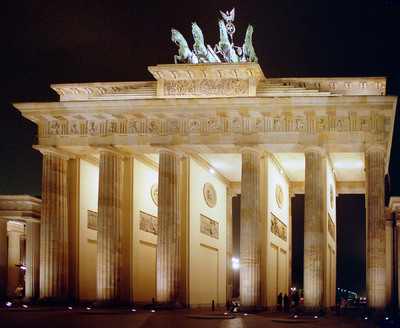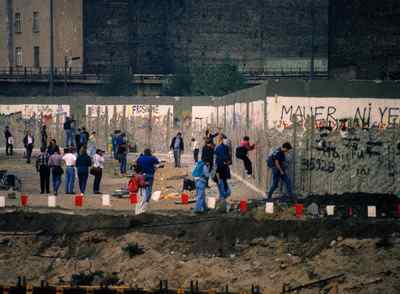- MENU
- HOME
- SEARCH
- WORLD
- MAIN
- AFRICA
- ASIA
- BALKANS
- EUROPE
- LATIN AMERICA
- MIDDLE EAST
- United Kingdom
- United States
- Argentina
- Australia
- Austria
- Benelux
- Brazil
- Canada
- China
- France
- Germany
- Greece
- Hungary
- India
- Indonesia
- Ireland
- Israel
- Italy
- Japan
- Korea
- Mexico
- New Zealand
- Pakistan
- Philippines
- Poland
- Russia
- South Africa
- Spain
- Taiwan
- Turkey
- USA
- BUSINESS
- WEALTH
- STOCKS
- TECH
- HEALTH
- LIFESTYLE
- ENTERTAINMENT
- SPORTS
- RSS
- iHaveNet.com: Travel
By Rick Steves

Brandenburg Gate - Berlin, Germany
As Germany celebrates the 20th anniversary of the fall of the Berlin Wall, I can't help remembering my spooky 1971 visit during the Cold War. When we crossed back to the West, tour buses were emptied at the border so mirrors could be rolled under the bus. They wanted to see if anyone was trying to escape with us.
Back then, life in the East was bleak, gray, and demoralizing because of ongoing political repression and their unresponsive Soviet-style command economy.
Today, Berlin feels like the nuclear fuel rod of a great nation. It's so vibrant with youth, energy, and an anything-goes-and-anything's-possible buzz that Munich feels spent in comparison.
A sleek Radisson Blu Hotel now stands on the place where the old leading hotel of East Berlin once stood. I remember staying there during the Cold War, when a West German 5-mark coin changed on the black market would get me drinks all night. Now five euros is lucky to get me a beer, and the lobby of the Radisson hosts an eight-story-tall exotic fish tank the size of a grain silo with an elevator zipping right up the middle.
As a booming tourist attraction, Berlin welcomed more visitors than Rome in 2009. The crush of tourists makes parts of the new Berlin tacky -- even some sights associated with the Wall. Checkpoint Charlie is a capitalist freak show. Lowlife characters sell fake bits of the wall, World War II-vintage gas masks, and East German medals. Two actors dressed as American soldiers pose for tourists between big American flags and among sandbags at the rebuilt checkpoint. Across the street at "Snack Point Charlie," someone sipping a Coke says, "When serious turns to kitsch, you know it's over."
However, the nearby
In the new Berlin, it's actually getting hard to find traces of the Wall. Look for a double row of cobbles in the streets marking the former path of the 100-mile "Anti-Fascist Protective Rampart," as the communists called it. These innocuous cobbles run throughout the city, even through some modern buildings.
The Wall's most iconic sight, of course, is the Brandenburg Gate. Built in 1791, it is the last survivor of 14 gates in Berlin's old city wall. The gate was the symbol of Prussian Berlin ... and later the symbol of a divided Berlin. It sat unused, part of a sad circle dance of concrete and barbed wire, for more than 28 years.
Postcards all over town still show the ecstatic day -- Nov. 9, 1989 -- when the world enjoyed the sight of happy Berliners jamming the gate like flowers on a parade float. The shiny white Brandenburg Gate was completely restored in 2002 (but you can still see faint patches marking war damage). When I'm there, I like to pause a minute and think about struggles for freedom -- past and present; there's a special room built into the gate for this very purpose.

Fall of the Berlin Wall - November 9, 1989
The last complete "Wall system" (with both sides of its Wall and its no-man's-land, or "death strip," all still intact) is now part of a sober little memorial, the Berlin Wall Documentation Center. Though it's directed at German-speakers and far from other sights, it's handy enough to the Nordbahnhof station of the S-Bahn (Berlin's elevated train system) that any Wall aficionado will find it worth a quick visit.
The largest slice of the Wall is now "the world's longest outdoor art gallery," the
The upcoming festivities to commemorate the historic fall of the Wall include setting up a mile-long stretch of colorful, eight-foot-tall dominoes along the path of the former wall near the Brandenburg Gate. In honor of the anniversary, the wall will fall again -- playfully.
No tour of Germany is complete without a visit to the reunited, revitalized Berlin. Over the last two decades, we've witnessed the rebirth of a great European capital. Today, as we enjoy the thrill of walking over what was the Wall and through the well-patched Brandenburg Gate, it's clear that history is not contained in some book, but is an exciting story happening today.
© Rick Steves by Tribune Media Services, Inc.
AUTOS | HOBBIES | EDUCATION | FAMILY | FASHION | FOOD & RECIPES | HOME DECOR | RELATIONSHIPS | PARENTING | PETS | TRAVEL | WOMEN
Vacation Travel - Berlin Germany Then and Now